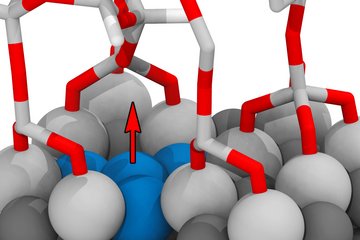All genres
41.
Journal Article
Combinatorial metallurgical synthesis and processing of high-entropy alloys. Journal of Materials Research 33 (19), pp. 3156 - 3169 (2018)
42.
Journal Article
Prediction of Martensite Start Temperature for Lightweight Fe–Mn–Al–C Steels. Journal of Phase Equilibra and Diffusion 39 (5), pp. 476 - 489 (2018)
43.
Journal Article
Synthesis and stabilization of a new phase regime in a Mo–Si–B based alloy by laser-based additive manufacturing. Acta Materialia 151, pp. 31 - 40 (2018)
44.
Journal Article
Development of high modulus steels based on the Fe – Cr – B system. Materials Science and Engineering A: Structural Materials Properties Microstructure and Processing 724, pp. 142 - 147 (2018)
45.
Journal Article
Spatially resolved localization and characterization of trapped hydrogen in zero to three dimensional defects inside ferritic steel. Acta Materialia 144, pp. 235 - 244 (2018)
46.
Journal Article
Deformation induced degradation of hot-dip aluminized steel. Materials Science and Engineering A: Structural Materials Properties Microstructure and Processing 710, pp. 385 - 391 (2018)
47.
Journal Article
Nickel-molybdenum alloy catalysts for the hydrogen evolution reaction: Activity and stability revised. Electrochimica Acta 259, pp. 1154 - 1161 (2018)
48.
Journal Article
Stiff, light, strong and ductile: nano-structured High Modulus Steel. Scientific Reports 7 (1), 2757 (2017)
49.
Journal Article
Combinatorial Alloy Design by Laser Additive Manufacturing. Steel Research International 88 (8), 1600416 (2017)
50.
Journal Article
Effect of silicon on the microstructure and growth kinetics of intermetallic phases formed during hot-dip aluminizing of ferritic steel. Surface and Coatings Technology 319, pp. 104 - 109 (2017)
51.
Journal Article
Strengthening Fe – TiB2 based high modulus steels by precipitations. Materials and Design 124, pp. 183 - 193 (2017)
52.
Journal Article
Properties of particle phases for metal-matrix-composite design. Data in Brief 12, pp. 692 - 708 (2017)
53.
Journal Article
Crystallisation of amorphous Fe – Ti – B alloys as a design pathway for nano-structured high modulus steels. Journal of Alloys and Compounds 704, pp. 565 - 573 (2017)
54.
Journal Article
Interstitial atoms enable joint twinning and transformation induced plasticity in strong and ductile high-entropy alloys. Scientific Reports 7, 40704 (2017)
55.
Journal Article
Combinatorial screening of the microstructure–property relationships for Fe–B–X stiff, light, strong and ductile steels. Materials and Design 112, pp. 131 - 139 (2016)
56.
Journal Article
Effects of Mn additions on microstructure and properties of Fe–TiB2 based high modulus steels. Materials and Design 111, pp. 185 - 191 (2016)
57.
Journal Article
Efficient additive manufacturing production of oxide- and nitride-dispersion-strengthened materials through atmospheric reactions in liquid metal deposition. Materials and Design 111, pp. 60 - 69 (2016)
58.
Journal Article
Atom probe tomography of intermetallic phases and interfaces formed in dissimilar joining between Al alloys and steel. Materials Characterization 120, pp. 268 - 272 (2016)
59.
Journal Article
Improving the mechanical properties of Fe – TiB2 high modulus steels through controlled solidification processes. Acta Materialia 118, pp. 187 - 195 (2016)
60.
Journal Article
Vessel microstructure design: A new approach for site-specific core-shell micromechanical tailoring of TRIP-assisted ultra-high strength steels. Acta Materialia 113, pp. 19 - 31 (2016)











